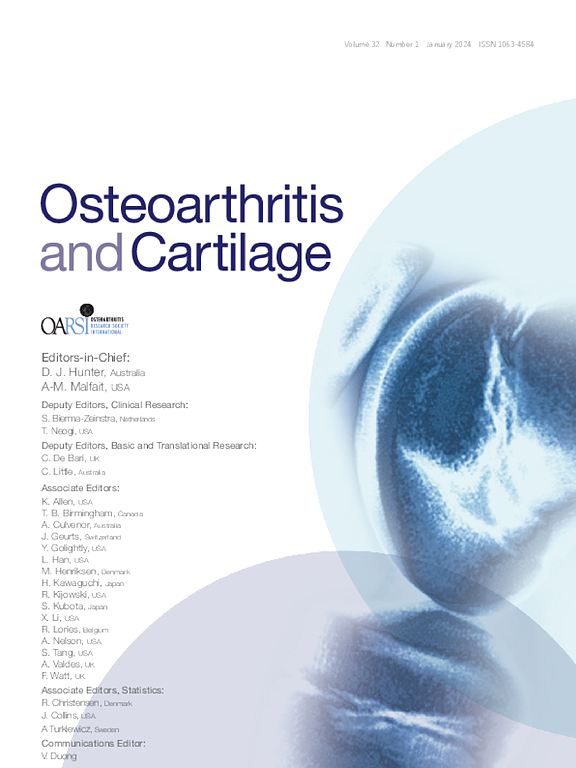Immunomodulation and fibroblast dynamics driving nociceptive joint pain within inflammatory synovium: Unravelling mechanisms for therapeutic advancements in osteoarthritis
IF 7.2
2区 医学
Q1 ORTHOPEDICS
引用次数: 0
Abstract
Objective
Synovitis is a widely accepted sign of osteoarthritis (OA), characterised by tissue hyperplasia, where increased infiltration of immune cells and proliferation of resident fibroblasts adopt a pro-inflammatory phenotype, and increased the production of pro-inflammatory mediators that are capable of sensitising and activating sensory nociceptors, which innervate the joint tissues. As such, it is important to understand the cellular composition of synovium and their involvement in pain sensitisation to better inform the development of effective analgesics.
Methods
Studies investigating pain sensitisation in OA with a focus on immune cells and fibroblasts were identified using PubMed, Web of Science and SCOPUS.
Results
In this review, we comprehensively assess the evidence that cellular crosstalk between resident immune cells or synovial fibroblasts with joint nociceptors in inflamed OA synovium contributes to peripheral pain sensitisation. Moreover, we explore whether the elucidation of common mechanisms identified in similar joint conditions may inform the development of more effective analgesics specifically targeting OA joint pain.
Conclusion
The concept of local environment and cellular crosstalk within the inflammatory synovium as a driver of nociceptive joint pain presents a compelling opportunity for future research and therapeutic advancements.
免疫调节和成纤维细胞动力学驱动炎性滑膜内的痛觉性关节疼痛:揭示骨关节炎治疗进步的机制。
目的:滑膜炎是一种公认的骨关节炎(OA)症状,其特点是组织增生,免疫细胞浸润增加,常住成纤维细胞增殖,形成促炎表型,并产生更多的促炎介质,这些介质能够敏化和激活支配关节组织的感觉痛觉感受器。因此,了解滑膜的细胞组成及其在痛觉敏感化过程中的参与度对开发有效的镇痛药具有重要意义:方法:使用 PubMed、Web of Science 和 SCOPUS 查找了有关 OA 痛觉敏感性的研究,重点是免疫细胞和成纤维细胞:在这篇综述中,我们全面评估了驻留免疫细胞或滑膜成纤维细胞与发炎的 OA 滑膜中的关节痛觉感受器之间的细胞串扰导致外周痛觉过敏的证据。此外,我们还探讨了阐明在类似关节病症中发现的共同机制是否可为开发专门针对 OA 关节痛的更有效镇痛药提供依据:结论:炎性滑膜内的局部环境和细胞串扰是引起痛觉性关节疼痛的驱动因素,这一概念为未来的研究和治疗进步提供了令人信服的机会。
本文章由计算机程序翻译,如有差异,请以英文原文为准。
求助全文
约1分钟内获得全文
求助全文
来源期刊

Osteoarthritis and Cartilage
医学-风湿病学
CiteScore
11.70
自引率
7.10%
发文量
802
审稿时长
52 days
期刊介绍:
Osteoarthritis and Cartilage is the official journal of the Osteoarthritis Research Society International.
It is an international, multidisciplinary journal that disseminates information for the many kinds of specialists and practitioners concerned with osteoarthritis.
 求助内容:
求助内容: 应助结果提醒方式:
应助结果提醒方式:


